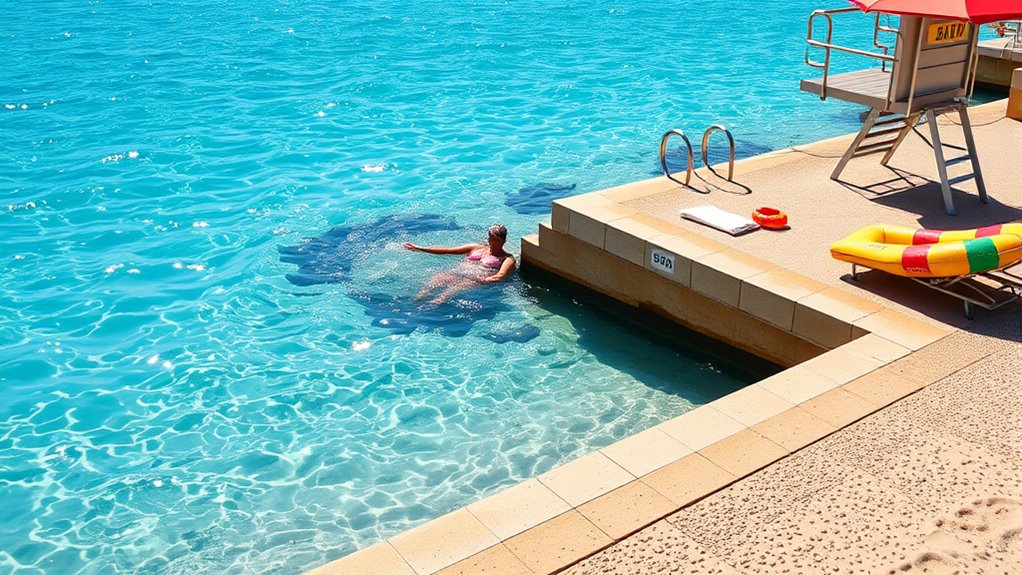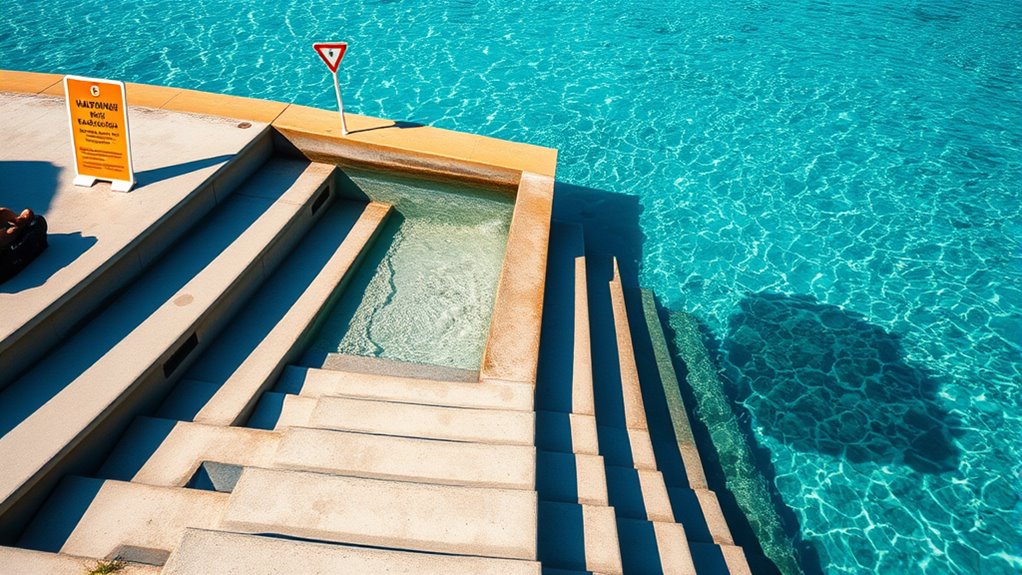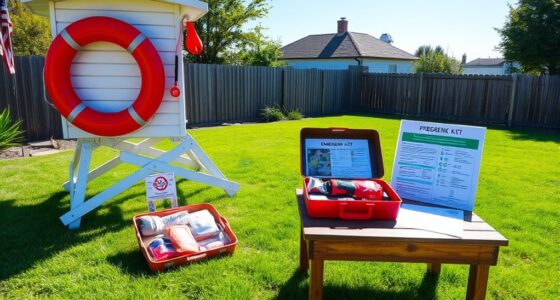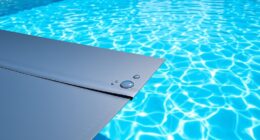When using beach entries and tanning ledges, watch out for slips caused by uneven, wet surfaces, algae, or debris that can make footing unstable. Pay attention to signage indicating depth changes, slippery zones, or hazards like sharp rocks. Use non-slip footwear and move cautiously near shallow or deep areas. Staying alert and respecting safety barriers helps prevent accidents. Continue exploring for more tips to keep your aquatic adventures safe and enjoyable.
Key Takeaways
- Watch for warning signs indicating slippery surfaces, depth changes, or hazards near beach entries and tanning ledges.
- Use non-slip footwear and proceed slowly to prevent slips on wet, uneven, or algae-covered surfaces.
- Monitor depth markers and signage to avoid unexpected drops or deep areas.
- Be cautious of hidden rocks, shells, or debris that can cause cuts or injuries.
- Stay within designated safe zones and avoid diving or jumping into shallow water to prevent accidents.
Recognizing Common Hazards at Beach Entries and Tanning Ledges

Recognizing common hazards at beach entries and tanning ledges is essential for ensuring your safety. You should be alert to uneven surfaces, which can cause slips or falls, especially when wet. Sharp rocks or shells might be hidden beneath the water’s surface, risking cuts or injuries. Be cautious of sudden drops or deep areas near entry points, as they can surprise you if you’re not paying attention. Algae or moss can make surfaces slippery, increasing the risk of falls. Additionally, debris like trash or broken glass may be scattered around, posing injury hazards. Staying vigilant and inspecting your surroundings is crucial, as hazard recognition helps you reduce the chance of accidents. Recognizing these hazards helps you enjoy the water safely and avoid unnecessary injuries.
Essential Safety Measures and Signage to Watch For

To stay safe at beach entries and tanning ledges, paying attention to safety measures and signage is key. Look for clear warning signs indicating depth changes, slippery surfaces, or hazardous areas. Always heed posted instructions, such as “No Diving” or “Slippery When Wet,” to prevent accidents. Pay attention to depth markers that show water levels, especially if they indicate shallow or sudden drops. Safety barriers, ropes, or fencing are often in place to keep you away from dangerous spots. Be cautious around areas with warning flags or signage indicating strong currents or unstable footing. Additionally, understanding beach safety guidelines can further help prevent slips and injuries. By observing these signs and safety measures, you help guarantee your safety and that of others, reducing the risk of slips, falls, and injuries.
Tips for Safe Navigation and Enjoyment of Aquatic Features

When guiding aquatic features like tanning ledges or beach entry points, staying attentive and cautious enhances both safety and enjoyment. Always watch your step and avoid rushing, especially in shallow or uneven areas. Keep an eye on the depth indicators and signage to prevent surprises. Use non-slip footwear if needed and proceed slowly around wet surfaces. Remember to stay within designated areas and avoid diving or jumping into shallow water. Be mindful of other swimmers and share space respectfully. Regularly check your surroundings for hazards like loose tiles or debris. If you feel unsure, pause and assess before continuing. Being alert and respectful ensures you have a fun, safe experience for everyone. Empowering seniors with personalized in-home care can also include guidance on safe aquatic activity practices tailored to individual needs.
Frequently Asked Questions
What Are the Recommended Age Restrictions for Using Tanning Ledges?
You should typically keep children under 14 away from tanning ledges, as they may not understand safety risks. For teenagers aged 14 to 17, supervision is highly recommended, and some facilities might require parental consent. Adults can use tanning ledges freely, but always follow posted safety signs. Remember, the key is to stay alert, avoid rough play, and make sure everyone understands the potential hazards for a safe experience.
How Often Should Signage Be Inspected and Maintained for Safety?
You should inspect and maintain signage regularly, ideally monthly, to guarantee safety. This frequent check helps you catch fading signs, damage, or obstructions that could cause accidents. Remember, signage isn’t just about compliance; it’s about protecting users from slips, falls, or misunderstandings about depths. By staying vigilant and proactive, you reinforce safety, build trust, and prevent potential hazards before they turn into costly incidents.
Are There Specific Safety Protocols for Disabled or Elderly Swimmers?
Yes, you should implement specific safety protocols for disabled or elderly swimmers. Always provide accessible entry points, such as ramps or lifts, and ensure staff are trained to assist them appropriately. Keep clear signage indicating accessible features and potential hazards. Regularly check that these facilities are functioning properly, and communicate safety instructions clearly. Making your environment inclusive and safe helps prevent accidents and guarantees everyone can enjoy the water responsibly.
What Are the Legal Liabilities for Facility Owners Regarding Safety Signage?
As a facility owner, you’re legally responsible for providing clear, visible safety signage to warn visitors about potential hazards. You must guarantee signs are properly maintained, easily understandable, and placed at strategic locations. Failing to do so can lead to liability if someone gets injured. Regularly review your signage policies, update them as needed, and make sure staff knows their importance to help protect visitors and reduce your legal risks.
How Can Users Report Hazards or Unsafe Conditions at Beach Entries?
You can report hazards or unsafe conditions at beach entries by contacting the facility management directly, either in person, via phone, or through their online reporting system. Make sure to provide detailed information about the specific issue, including location, nature of the hazard, and any photos if possible. Prompt reporting helps guarantee the facility can address the problem quickly, reducing risks for everyone and maintaining safety standards.
Conclusion
By staying alert and respecting posted signs, you can enjoy the beach entry and tanning ledge safely. Remember, even if it’s crowded or looks inviting, hazards like slippery surfaces or unexpected depths can catch you off guard. Visualize yourself confidently maneuvering these areas, avoiding slips and surprises. With awareness and caution, you’ll make your aquatic experience safe, fun, and worry-free—so you can relax and soak up the sun without a second thought.









